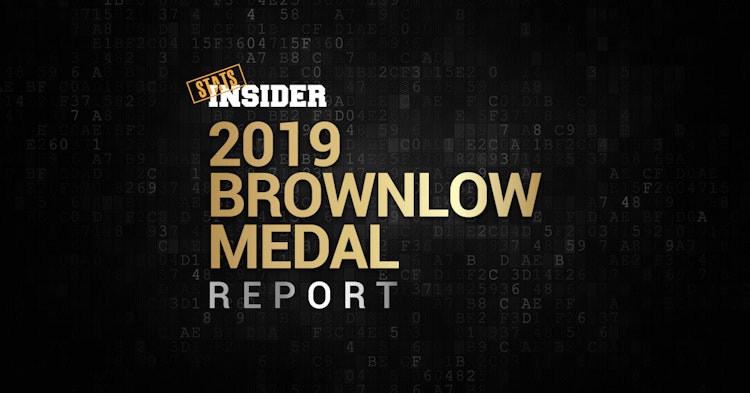The Brownlow Model: A Unique Approach in 2019
Last updated: Sep 12, 2019, 1:14AM | Published: Sep 3, 2019, 11:08PM
Tackling the problem of modelling the AFL Brownlow Medal is unique in sports prediction.
DOWNLOAD STATS INSIDER'S FREE 2019 BROWNLOW REPORT
The goal is not to build an algorithm to identify the best players in any given match, but rather, to identify the players the umpires officiating that game would think were the best three players, and in which order.
So, how does one predict an umpire’s perception?
Stats Insider’s approach to answering this question was to first gather as much data as possible from each AFL game between 2014-2018 and train an ordinal logistic regression model on past Brownlow votes to find which variables were the ones most likely to catch the eye of the umpires, and thus correlate to Brownlow Medal votes for that game. That list of statistics is too long to detail here, as we used over 40 different in-game statistics for each player who ran out in every match over this 5-year period.
Using a regression model such as this is a well-worn path for people that have taken on the task of building a Brownlow Medal model, so we also identified other variables beyond in-game statistics to make our model more robust, including a more ‘human’ element with the addition of various media votes into the algorithm.
It is not enough to use just one source for this, as biases - intentional or not - may take place, so we tracked down several different outlets who supplied votes for each game over the past five AFL seasons, as well as using the AFL Coaches Association (AFLCA) votes. Adding these variables to our model produced much higher predictive value than just stats-based regression, and satisfied our goal of building a model that combined both raw data and a ‘wisdom of the crowds’ human approach.
The media vote percentage (which you'll see on the Round-by-Round pages in the report) is derived from the maximum amount of votes a player can receive in a game. For example, if a player has 100% of media votes, that means they were unanimously judged as best on the ground for that match according to the outlets canvassed. This includes the maximum 10 votes from the AFL Coaches Awards, as well as the maximum 3 votes from each of the media outlets. If a player were to receive 44% from 'the media' that might mean they received 2 votes from one outlet, 1 vote from another outlet and four votes from the AFLCA for a total of 7 out of a possible 16 maximum media votes (3+3+10). This number expressed as a percentage is 44%.
For each player, in every match, our model gives us a probability of that player polling 1, 2 or 3 votes. We’ve then simulated the 2019 AFL season 10,000 times and assigned votes to each player based on these underlying probabilities. By aggregating these simulations, we were able to compute the probabilities and ‘fair odds’ for the different Brownlow Medal betting markets.
DOWNLOAD STATS INSIDER'S FREE 2019 BROWNLOW REPORT
What do we mean by ‘fair odds?’
Fair odds are the price our probabilities indicate the player or market should be at if the bookmakers were to generate a 100% market (paying out as much as people bet). Anything above this price would represent value, assuming the model is accurate.
To identify fair odds in this case, where there are opportunities for dead heats in some of the markets, we have assessed a ‘tie’ in one of our simulations as a fraction of a win, ie; if three players tie for the Brownlow Medal in 2019, we have awarded each player ⅓ of a Brownlow Medal.
Some interesting figures emerged from the model in relation to possible ties. Based on our 10,000 simulations of the 2019 Brownlow Medal, we have identified:
- 218 simulations with a 3-way dead heat;
- 34 simulations with a 4-way dead heat;
- 4 simulations with a 5-way dead heat.
The more common combinations of tied winners include:
- Dangerfield / Fyfe (317 simulations)
- Dangerfield / Bontempelli (277 simulations)
- Fyfe / Bontempelli (118 simulations)
- Neale / Dangerfield (108 simulations)
While some of the more intriguing outright winner dead heats include:
- Dangerfield / Kelly Geelong double (21 simulations)
- Bontempelli / Macrae Western Bulldogs double (14 simulations)
- Neale / Dangerfield / Fyfe / Bontempelli 4-way tie (5 simulations)
- Shuey / Fyfe West Australian double (2 simulations)
- Neale / Zorko Brisbane double (1 simulation)
We hope you enjoy our 2019 Brownlow Medal Report, and please remember if you are having a punt on Charlie to always gamble responsibly.
- Stats Insider
Did you enjoy this article? Leave a comment below, or join the conversation on the Stats Insider Twitter or Facebook page.



